There’s a lot to get excited about with chatamari.
Even when described as a “Nepali rice crepe,” we were already intrigued. Little did we know, however, how short that description actually sells the recipe itself.
Because once you have a taste, you’ll understand that chatamari is far more than any old “rice crepe” could be.

Chatamari and Overall Newari Cuisine
To understand chatamari and its ubiquity – both as a street snack and as an offering for finer dining – it’s helpful to learn about the recipe’s root culture and cuisine: the Newars.
For nearly as long as there’s been a documented history of civilization in the Kathmandu Valley (in which Kathmandu, Nepal’s capital and largest city, lies), there has been a highly correlated and corresponding history of the Newari people.
The first traces of the Newari people goes back as far as the 3rd century BC with the first settlers into the amply fertile Kathmandu Valley, itself a primordial lake that had emptied over the course of 30,000 years. The Newars rapidly developed a peaceful and highly developed sovereignty over the land, and they remained the predominant force in the Valley for well over two millennia.
That’s not to say that there weren’t outside influences coming in, though. As a landlocked connector between great ancient empires like India, China and Tibet, the Kathmandu Valley served as the brokering middle point between opposite sides. A good portion of the Newar economy during this time involved, interestingly, serving as arbiters between various trading parties. Of course, they had their own crops to export as well – rice being the main one – but they certainly profited from their set of “geographical advantages.”
Around the mid-18th century, a ruler from the Gorkhali principality neighboring the Kathmandu Valley, Privthi Narayan Shah, invaded and conquered the Valley as part of a campaign to create a unified Kingdom of Nepal. Following his success and the creation of the kingdom, King Shah instilled a systematic and pretty brutal suppression of the Newars in order to curb any political dissent and potential fracturing of the Kingdom.
Since that conquest and the Kingdom’s advent, the Newar domination of the Kathmandu Valley has slowly and gradually diminished. Today, also in part to mass migration to Kathmandu and its surroundings, the once-dominant Newars are now only the 6th largest group in their former lands.
Nevertheless, their presence and influence can be felt everywhere… even in the “Nepal” name! It’s a common thought that the word Nepal is actually a Sanskrit-derivative of Newar, where the “P” and “L” are mutations of the original “V” and “R,” respectively.
And, of course, the Newari presence is felt in their food… chatamari included.
If you like Nepali cuisine, make sure you check out our other article on steamed dumplings – Momos.
Newari Cuisine
When one of the common greetings relates to food – you say hello with Ja naye dwuno la? but really it means “have you had your rice?”- it’s hard to understate the importance of food in Newari culture. It’s everywhere.
In general, though, the Newari cuisine can be split into three different types: the daily meals (called ja), the afternoon snacks (called baji), and ceremonial or festival food (called bhoye). But considering that many baji foods – chatamari included – serve as the base for bhoye foods, even that delineation remains a bit murky.
The ja meals are usually eaten at the morning and evening book-ends of the day and at home. Most ja meals traditionally involved boiled rice combined another staple ingredient, which were then to be eaten in silence.
Baji, on the other hand, were midday snacks enjoyed in a much more social setting. Most baji are made from flattened rice and could be quick “on the go” snacks that people could eat while working in the fields during harvesting season.
Chatamari itself falls primarily under the baji category, although it too is eaten during festivals and other special occasions alongside other bhoye foods. Nowadays, chatamari can be found virtually everywhere in Nepal, be it as an appetizer in a restaurant, a main dish at an eatery or still as a street snack enjoyed by both Newaris and non-Newaris alike.
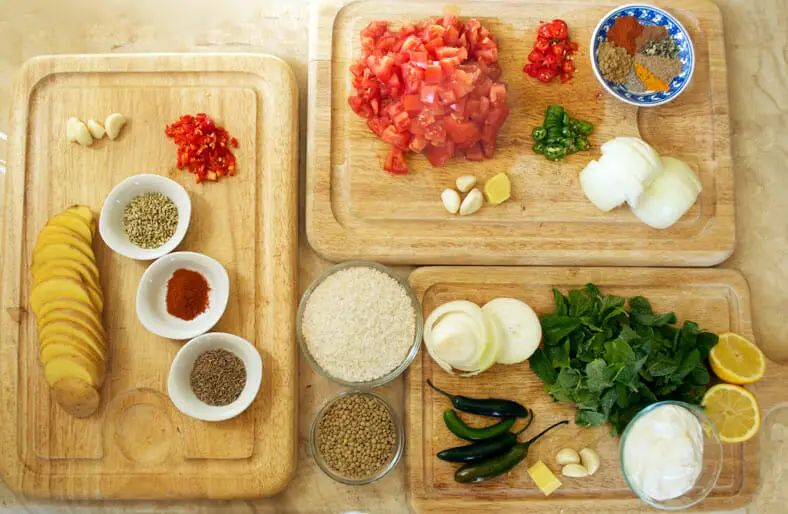
About the Recipe
Technically, the actual making of chatamari – the “rice crepe” part, that is – is incredibly simple.
First, you’ll start with creating your rice batter. You start with your rice base, which can be either rice soaked overnight then ground into a meal or, more easily, rice flour. Next, you add lentils soaked and ground into a paste along with water and a touch of salt. Some recipes might suggest adding cumin, both in seed and in powder form, but this is an additional add than a core ingredient.
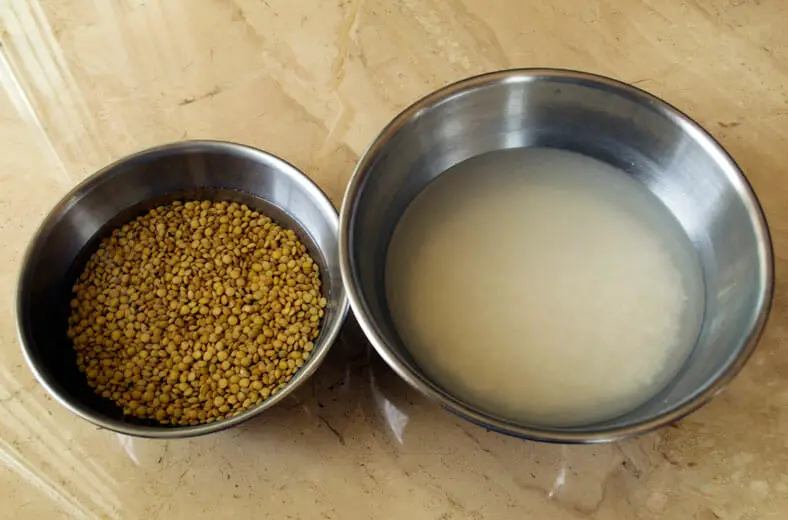
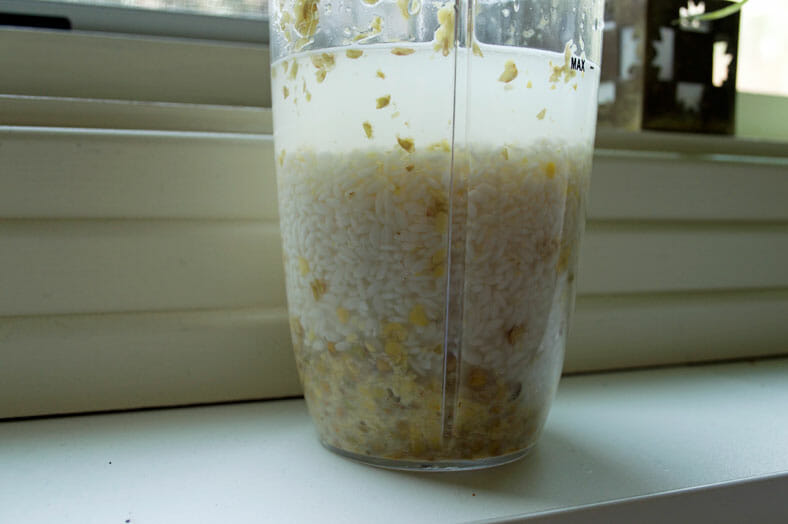 The lentil paste, however, should be part of your chatamari batter. Some recipes might suggest just making your batter with just your rice meal/flour, but the lentil paste plays a very important role in ensuring your chatamari comes out just right. As the lentils heat, they help the rice and the rest of the batter unstick from the bottom of the pan, which allows for an easier removal of your chatamari once cooked. As an added bonus, the lentils helps add a small crispy texture to the bottom of your chatamari as well.
The lentil paste, however, should be part of your chatamari batter. Some recipes might suggest just making your batter with just your rice meal/flour, but the lentil paste plays a very important role in ensuring your chatamari comes out just right. As the lentils heat, they help the rice and the rest of the batter unstick from the bottom of the pan, which allows for an easier removal of your chatamari once cooked. As an added bonus, the lentils helps add a small crispy texture to the bottom of your chatamari as well.

While chatamari is the “main event,” it’s is hardly complete without any sort of traditional topping and sauces on it. In fact, you might even make the case that it’s not chatamari at all!
Depending on from whom and where you get your chatamari, the topping can be just about anything you’d like, which is one of the inherent beauties of this very flexible recipe. You can add a minced meat stir fry, a whole egg to poach and steam, or a smorgasbord of vegetarian-friendly toppings.
The key to cooking your chatamari is that you cook it with your toppings already on it. For this reason, it helps to have your toppings already made ahead of time.
Once it’s showtime, you start by adding a very thin layer of batter over the bottom of your heated pan. As with any other crepe-like dish, it’s very beneficial if you can spread the batter as thinly, evenly and widely as your pan would allow.
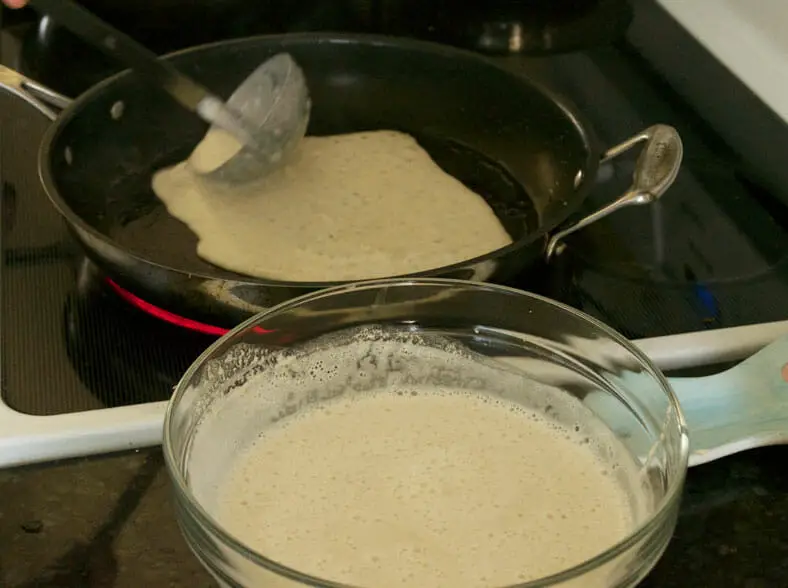
From there, you will add your toppings and then cover the pan and let the chatamari steam until it is fully cooked. There is a slight challenge in making sure that the accumulated steam (condensed back into water) doesn’t drip back onto the cooking chatamari, but that’s perhaps the only major consideration you need to consider for this otherwise incredibly simple dish.
 After several minutes of “mutual steaming,” you should be able to easily slide the chatamari out of the pan and onto your serving plate. If it slides super easily for you as it did for us, then you can thank the lentil paste for that.
After several minutes of “mutual steaming,” you should be able to easily slide the chatamari out of the pan and onto your serving plate. If it slides super easily for you as it did for us, then you can thank the lentil paste for that.
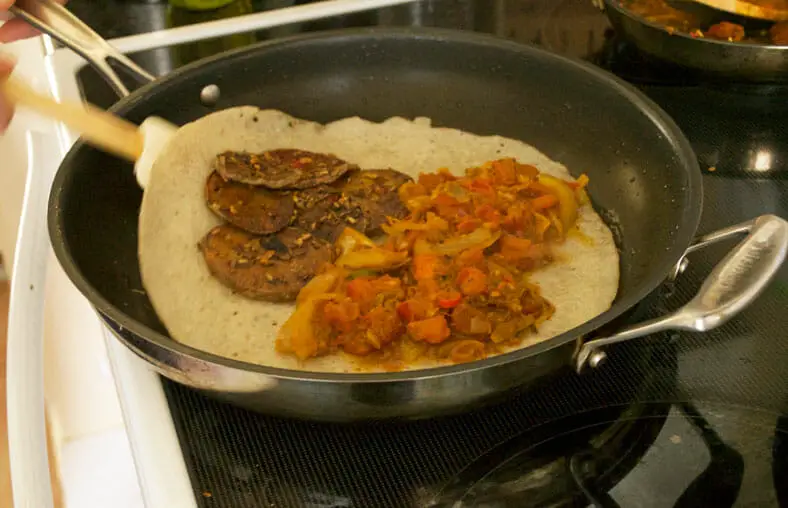
Our Take on the Recipe
Over our own research, one thing kept bugging us about various recipes: each recipe would suggest a topping, but they wouldn’t really explain why that topping was chosen.
So for our version of chatamari, we decided to make a variation of another Nepali dish, aloo tareko, for one of our vegan-friendly toppings. Generally, Newari cuisine makes abundant use of mustard oil and various aromatic ingredients like cumin seeds, fennel seeds, mustard seeds, garlic, ginger and so on, so we made sure to include enough of these types of ingredients to stay true to the Newari way.
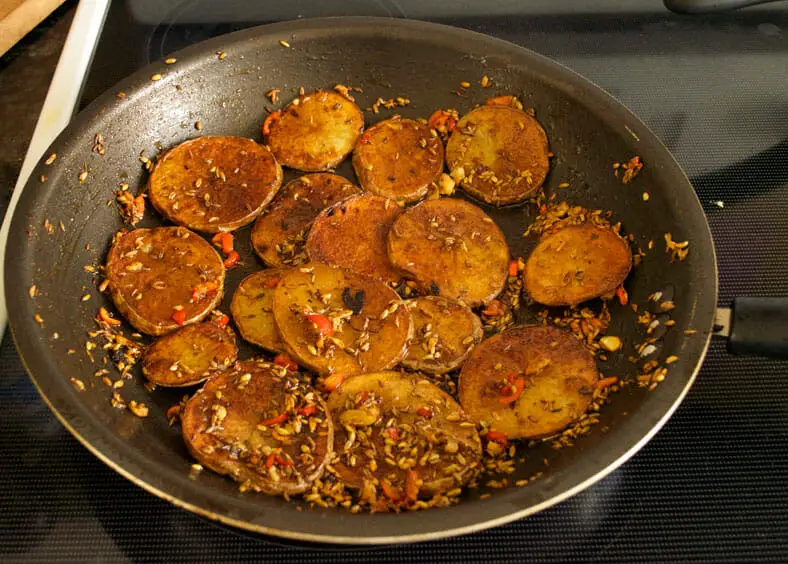 For the other topping, we made a vegan-friendly version of the topping outlined in our original reference recipe. With the exception of removing the meat and upping the amount of tomato, it was a fairly simple adjustment to make.
For the other topping, we made a vegan-friendly version of the topping outlined in our original reference recipe. With the exception of removing the meat and upping the amount of tomato, it was a fairly simple adjustment to make.
 With regards to the chatamari itself, we did try both approaches of soaking rice versus using rice flour, and our personal preference was to soak the rice and then grind it into a meal. That’s our own preference, though, and it might not be worth the small amount of extra work of pre-soaking and processing. To give credit to the rice flour, it was easier to maneuver around the pan upon pouring.
With regards to the chatamari itself, we did try both approaches of soaking rice versus using rice flour, and our personal preference was to soak the rice and then grind it into a meal. That’s our own preference, though, and it might not be worth the small amount of extra work of pre-soaking and processing. To give credit to the rice flour, it was easier to maneuver around the pan upon pouring.
For cooking the chatamari, we also made a slightly “radical” shift in our cooking as well. As opposed to immediately adding the toppings then steaming, we actually let our chatamari first steam alone for a minute and then we added our toppings before continuing on our steaming way. We didn’t see this technique used in any other chatamari recipe we came across, but it was one that worked really well in our own tests.
Finally, we made an additional sauce for our chatamari as a garnishment, albeit a non-vegan-friendly one. We made a version of babari ko achar, or a spicy mint yogurt chutney, to drizzle on top for those that wanted. Little did we know how amazing it would also be on other dishes as well.
In all, though, chatamari is a versatile and delightful dish that gets better with each topping!
What topping would you have on your chatamari? Comment below!
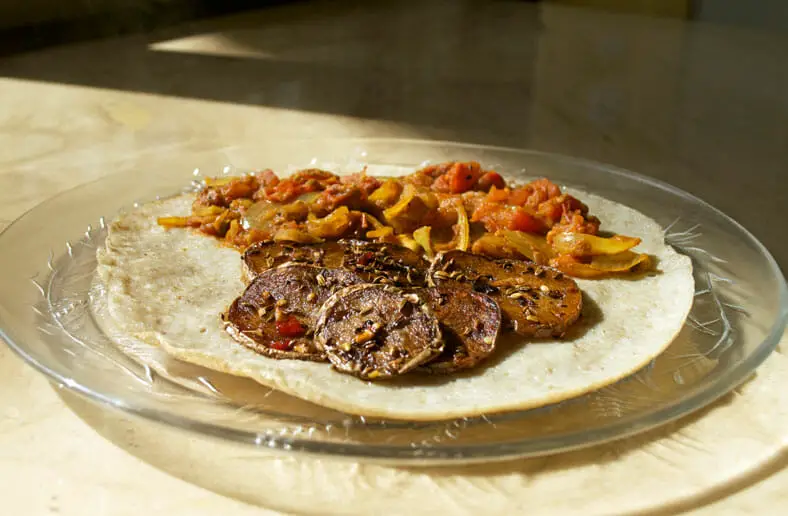


Chatamari
- Total Time: 25 minutes
- Yield: 4 people 1x
Description
Chatamari with grain rice (or 1 cup ground down rice flour).
Ingredients
Chatamari
- 1 cup of water
- 1 cup short grain rice (or 1 cup ground down rice flour)
- ⅓ cup lentils (we used green lentils)
- ½ teaspoon of salt
- At least 3 tablespoons coconut oil (for greasing pan)
Topping 1 (Optional)
- ½ cup diced tomato
- ¼ cup medium-sized onion, sliced thinly
- 3 cloves garlic, minced
- 1 inch piece of ginger, minced
- 2 chilis (either green or red), sliced thinly
- 1 teaspoon turmeric powder
- 1 teaspoon chili powder
- 1 teaspoon ground cumin
- 1 teaspoon ground coriander
- 1 teaspoon black pepper
- 1 teaspoon fennel seeds
- 1 teaspoon dried parsley
- 2 tablespoons olive oil
Topping 2 – Aloo Tareko (Optional)
- 1 russet potato, sliced thinly
- 1 teaspoon fennel seeds
- 1 teaspoon cumin seeds
- 1 teaspoon chili powder
- 2 cloves garlic, minced
- 2 red chilis, minced
- 2 tablespoons olive oil
Babari ko Achar Mint Sauce (Optional – and note it’s not not vegan-friendly)
- 1 cup of fresh mint
- 1 cup of Greek yogurt
- 3 serrano chili peppers, chopped
- 3 cloves garlic, minced
- 1 inch piece of ginger, minced
- ½ medium-sized onion, chopped
- Juice of 1 lemon
Garnish (Optional)
- Green onions
Instructions
Stage 1 – Pre-Soaking Rice and Lentils
- At least 4 hours prior to cooking (although more preferably the night before), submerge your lentils and rice in cold water (in separate bowls) and let soak. If you’re using rice flour instead of rice grains, then only soak your lentils ahead of time
- Once they’re done soaking, drain and set your rice aside
- Take your lentils and remove the skin. You can do this in one of two ways: either quickly pulse them in the food processor (on Amazon) (not too long, though, otherwise you’ll prematurely make a paste) or individually peel them. If you pulse in the food processor (on Amazon), remove the lentils and run water through as you fish the skins that float to the top
- Once your lentils are peeled, quickly pulse again in the food processor (on Amazon) (but still not making a paste), then set aside
Stage 2 – Prepare Toppings
- For Mint Sauce (If Making It)
- Combine your mint, chili peppers, Greek yogurt, garlic, onion, ginger and lemon juice into a food processor
- Process until you get a very smooth consistency in the sauce (and it has a light green color to it), then remove and set aside
- For Topping 1
- Heat a saucepan to over medium-high heat and add your olive oil
- Once the oil is heated, add your fennel seeds. Cook for several seconds as they brown and start to roast
- Next, add your onions, garlic, ginger and chili peppers. Mix around and cook for 1-2 minutes as they start to soften
- Add your tomatoes and then all the spices (turmeric, chili powder, cumin, coriander, black pepper, and dried parsley) shortly thereafter. As the tomatoes start to soften and help create a saucier consistency, mix the spices so they distribute well throughout
- Turn the heat to a low simmer and let sit for ~15 or so minutes while you tend to Topping 2. Stir occasionally when you can
- For Topping 2
- In another saucepan, heat your olive oil over medium high heat
- Once the oil is hot, add your fennel seeds and cumin seeds and roast until brown as you did with Topping 1
- Next, add your garlic, chilis, and ½ of the chili powder to the oil. This will help flavor the oil for when the potatoes roast
- Add your potatoes and place flat onto the pan so that they receive direct heat on the max amount of surface area. Cook for 5-7 minutes
- Before turning your potatoes over, sprinkle the remaining chili powder over the top, then flip the potatoes over. Fry for another 5-7 minutes or until you can easily poke a fork through the potato slices
- Once cooked through, take the saucepan off the heat and set aside. Do the same for Topping 1 as you move towards making the actual chatamari
Stage 3 – Creating the Crepe Batter
- In your food processor, combined your rice, lentils, salt and water. Process together until all the ingredients are well combined and create a runny batter
- Pour your batter into a bowl and have a ladle handy for when it’s cooking time
Stage 4 – Cooking the Crepe
- Take a wide-diameter pan (one that can be eventually covered) over medium heat and add a small bit of your coconut oil. Use a paper towel to evenly distribute the oil
- With a ladle, take a large scoop of your batter and, with the surface of your pan very hot, spread across the surface as thinly as you can
- Once your batter is spread, put the cover on the pan and let it steam alone for 1 minute
- After a minute, remove the pan cover but be very quick to not let any of the condensed water drip back into the pan
- Add a bit of each of your toppings onto the chatamari, then re-cover the pan and steam for at least another 4-5 minutes.
- Next, uncover the pan (again, be very careful not to let accumulated water drip back into the pan) and take a spatula or other flat instrument to ensure the chatamari is unstuck from the pan. Once it is, it can slide of very easily and onto a plate.
- Repeat this Stage 4 until all your batter and toppings have been used up, serving as you go along
- Prep Time: 10 mins
- Cook Time: 15 mins
- Cuisine: Nepali


My husband who is gluten-free would love this crepe! And those toppings look delicious!
That’s awesome to hear, Manila Spoon! If you give it a try, let us know how you both like it!
STAMP: APPROVE!
The toppings are delicious. (I love fennel seeds!) They layer so well within the crepe and the crepe is such a good base. I thoroughly enjoyed this dish!
Thanks for letting us know, Erin! From one fennel seed lover to another, we totally agree with everything you said 🙂
oh wow this looks absolutely delicious- I am obsessed with fennel seeds and I’m the only one in the family who does haha!
Hahah well you’ve got a set of amigos over here who are equally obsessed with fennel seeds Arman. And we can attest that the Chatamari was indeed delicious!